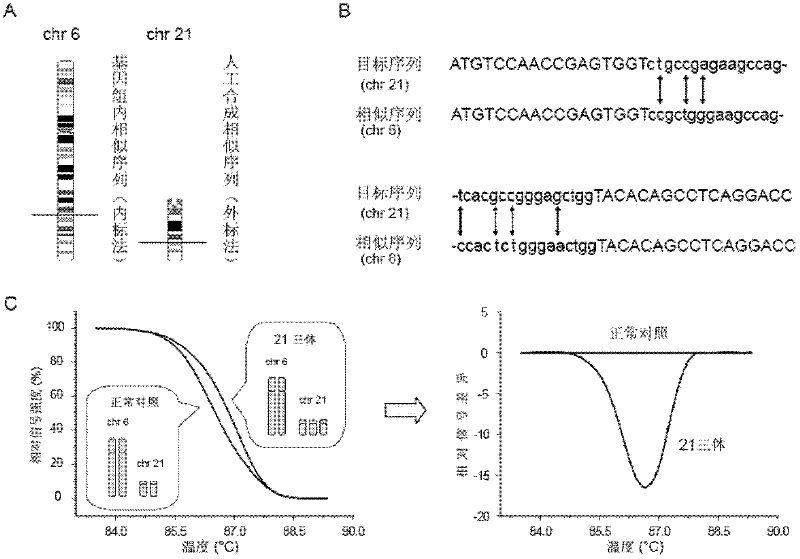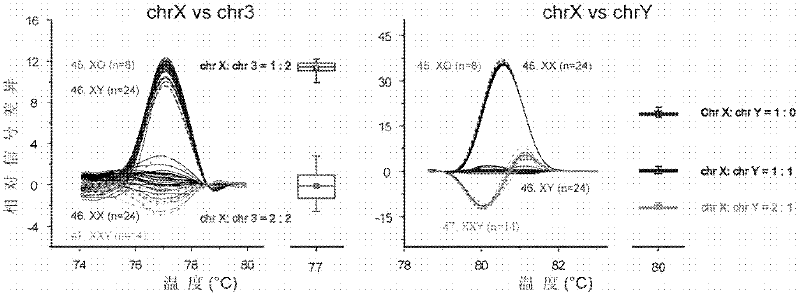Method for detecting gene copy number variation
A gene copy number and detection method technology, which is applied in the field of gene copy number variation detection using similar sequences combined with high-resolution melting curve analysis, can solve the problem of inability to distinguish between two allelic sequences, heterozygous SNP sites, and low detection sensitivity and other issues, to achieve the effect of improving sensitivity and specificity, accurate results, and high sensitivity
- Summary
- Abstract
- Description
- Claims
- Application Information
AI Technical Summary
Problems solved by technology
Method used
Image
Examples
Embodiment 1
[0037] Example 1 Detection of human autosomal copy number variation by internal standard method
[0038] Trisomies 21, 18, and 13 are the three most common autosomal aneuploidies in humans. Trisomy 21, also known as Down syndrome, occurs in about 1 in 700 live babies. Down syndrome comprises a spectrum of genetic disorders that lead to high-level deformities including learning disabilities, intellectual disabilities, and disabilities. The disease cannot be cured the day after tomorrow, so it is particularly important for the prenatal diagnosis of Down syndrome. The incidence rates of trisomy 18 and trisomy 13 are about 1 / 5000 and 1 / 25000, and the affected fetuses have serious deformities and physiological defects, so the prenatal diagnosis of the two is also very important.
[0039] 1. Materials
[0040] 1. Instrument:
[0041] Real-time fluorescent PCR instrument, pipette, centrifuge.
[0042] 2. Primer design:
[0043] The present invention selects a similar sequence o...
Embodiment 2
[0064] Example 2 Detection of Human Sex Chromosome Copy Number Variation by Internal Standard Method
[0065] Except for trisomy 21, most of the chromosomal aneuploidies that can survive after birth are sex chromosome aneuploidies, such as 45, X and 47, XXY. The incidence of sex chromosome aneuploidy is relatively high, such as 45 in females, the ratio of X is about 1 / 2000, and the ratio of 47, XXY in males is about 1 / 1000. Sex chromosome aneuploidy has a certain impact on the phenotypic development of patients, especially in the reproductive system. Although sex chromosome aneuploidy cannot be cured, early detection of sex chromosome aneuploidy and supplemented with hormone therapy during development can effectively alleviate symptoms. Therefore, early and rapid diagnosis of sex chromosomes is particularly important.
[0066] 1. Materials
[0067] 1. Instrument:
[0068] Real-time fluorescent PCR instrument, pipette, centrifuge.
[0069] 2. Primer design:
[0070] The pr...
Embodiment 3
[0091] The detection of trisomy 21 DNA under the background of embodiment 3 normal genome DNA
[0092] A chimera refers to an individual with cells of two or more genotypes. Depending on the proportion of abnormal cells, mosaicism manifests as a range of pathologies that vary in severity. In general, the greater the proportion of abnormal cells, the more severe the symptoms.
[0093] At present, non-invasive prenatal diagnosis mainly refers to obtaining the genetic information of the fetus through the detection of fetal free DNA or RNA in maternal blood, so as to avoid the risk of invasive sampling, which is the development direction of prenatal diagnosis in the future. Studies have shown that the amount of cell-free DNA in the fetus in the first trimester accounts for about 10% of the total amount of cell-free DNA in the mother's plasma, and the lower content has very strict requirements for detection technology.
[0094] In order to illustrate the application ability of th...
PUM
 Login to View More
Login to View More Abstract
Description
Claims
Application Information
 Login to View More
Login to View More - R&D
- Intellectual Property
- Life Sciences
- Materials
- Tech Scout
- Unparalleled Data Quality
- Higher Quality Content
- 60% Fewer Hallucinations
Browse by: Latest US Patents, China's latest patents, Technical Efficacy Thesaurus, Application Domain, Technology Topic, Popular Technical Reports.
© 2025 PatSnap. All rights reserved.Legal|Privacy policy|Modern Slavery Act Transparency Statement|Sitemap|About US| Contact US: help@patsnap.com



